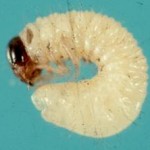Blackheaded pasture cockchafer (Acrossidius tasmaniae) impacts seedling cereals and pastures in Tasmania, Victoria, South Australia and New South Wales.
| Insects and damage | Larvae live in the soil, are “C” shaped and white with a black head capsule. Adults beetles are most visible in summer, particularly after rain and may be attracted to lights.
|
| Monitoring | Inspect susceptible paddocks prior to sowing, or when signs of damage are evident.
|
| Beneficials | Natural enemies include birds, parasitic flies, predatory insects and diseases, but biological control generally does not prevent crop loss when larval populations are high. |
| Cultural control |
|
| Thresholds | If densities exceed 30 per m², control is warranted. An average infestation of 30-40 larvae per m² can cause a 50-70% reduction in winter pasture production and a 40-50% loss of desirable pasture species production in spring.
Thresholds for winter cereals are the same as those suggested for pasture, 30 larvae per m². |
| Pesticides |
|
| Considerations | Cockchafers do not thrive in very sandy or very heavy clay soils and numbers are greatly reduced in moisture saturated soils. Eggs and larvae desiccate in dry conditions and many also die in very wet conditions. They are more frequently a pest in areas where the annual rainfall exceeds 480 mm. |
| Communication | Cockchafers will not inhabit just one farm but more likely to occur in regions – area wide management can contribute to information transfer between neighbours and more effective control strategies Industry publications provide up-to-date information about regional pest issues in field crops |
Further information
- Blackheaded pasture cockchafer (cesar PestNotes)

